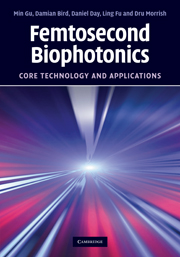Book contents
- Frontmatter
- Contents
- Preface
- 1 Introduction
- 2 Nonlinear optical microscopy
- 3 Two-photon fluorescence microscopy through turbid media
- 4 Fibre-optical nonlinear microscopy
- 5 Nonlinear optical endoscopy
- 6 Trapped-particle near-field scanning optical microscopy
- 7 Femtosecond pulse laser trapping and tweezers
- 8 Near-field optical trapping and tweezers
- 9 Femtosecond cell engineering
- Index
4 - Fibre-optical nonlinear microscopy
Published online by Cambridge University Press: 07 May 2010
- Frontmatter
- Contents
- Preface
- 1 Introduction
- 2 Nonlinear optical microscopy
- 3 Two-photon fluorescence microscopy through turbid media
- 4 Fibre-optical nonlinear microscopy
- 5 Nonlinear optical endoscopy
- 6 Trapped-particle near-field scanning optical microscopy
- 7 Femtosecond pulse laser trapping and tweezers
- 8 Near-field optical trapping and tweezers
- 9 Femtosecond cell engineering
- Index
Summary
The techniques introduced in Chapters 1 and 2 are emerging technologies that offer significant promise as tools for diagnostic imaging at the cellular level. Using devices founded on well established techniques such as confocal microscopy and confocal fluorescence microscopy, instruments capable of providing point-of-care pathological analysis of malignant and cancer causing tissues are becoming practical realities. Through examination of the physical properties of inherent autofluorescence or fluorescent dyes that are used as markers in conjugation with biological samples, very good detection of cellular processes can be achieved. Tagging of target biological cells makes it possible to examine cells in vivo and achieve real time three-dimensional (3D) visualisation for diagnosis of the pathological state.
However, the inherent nature of these devices is such that the conditions under which these techniques can be applied is fundamentally limited. In most cases (for definitive analysis) a surgical biopsy is performed on the patient and the sample is extensively prepared for observation by the pathologist on bulk, bench-top imaging apparatus. Ideally, examination of whole, intact specimens within internal cavities of the body would be the preferred method that may decrease patient trauma and eliminate diagnosis lag time.
One of the recent developments in confocal fluorescence microscopy is the introduction of optical fibres and fibre-optical components into the microscope geometry. Optical fibre couplers in particular offer the most compact and cost effective solution.
- Type
- Chapter
- Information
- Femtosecond BiophotonicsCore Technology and Applications, pp. 51 - 85Publisher: Cambridge University PressPrint publication year: 2010



